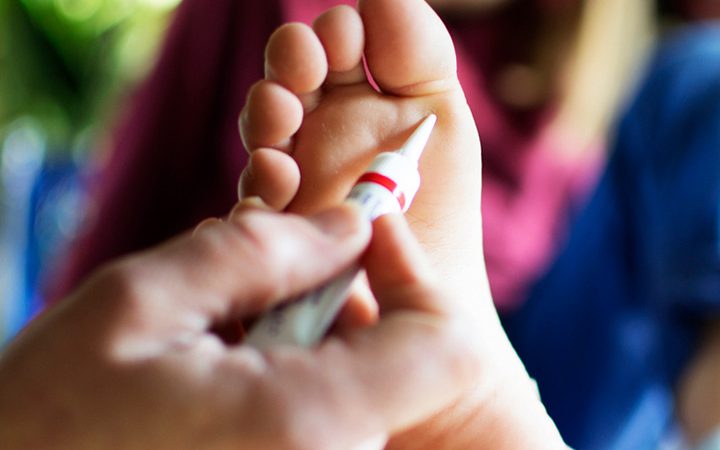Warts are small growths on the skin and are caused by the human papillomavirus (HPV). Although not harmful, they are contagious and spread easily. Warts can occur in both adults and children. In children, warts are most likely to occur on their hands, feet, and fingers, but can also spread to other parts of the body.
Read this post to learn the various causes, symptoms, and treatment options for warts on kids.
What Causes Warts In Children?
Children get warts on their skin when they are infected by HPV. Different types of papillomaviruses cause different types of warts. Children could get warts when they come in contact with the virus in the following ways (1) (2).
- Touching an infected person
- Using objects that have been touched by an HPV-infected person
- Touching surfaces or floors that have the virus from another infected person
- Staying barefoot in public places, such as locker rooms
Are Warts In Children Contagious?
Warts are contagious since they are caused by a virus. They usually spread via skin-to-skin contact or when a child touches an object or surface that has been contaminated by an infected person. Scratching an existing wart and then touching healthy skin could spread the wart to other parts of the body.
The chances of contracting the HPV virus and developing a wart are higher if your child has a cut or an open wound (1). Children with weak immune systems may usually have a higher risk of developing warts.
What Are The Different Types Of Warts Found In Children?
Warts can be of different types, and each may cause varied symptoms in children (2).
1. Common warts
These warts have a rough surface and appear grayish-yellow or brown. Common warts can be found on fingers, elbows, knees, and even on the face in children.
2. Palmar and plantar warts
These warts are called palmar when they occur on palms and plantar when they occur on the soles. They might be painful since palms and soles often experience frequent pressure and friction. A group of plantar warts is called mosaic.
3. Flat warts
These warts are small and appear as smooth skin growths. They are most commonly found on the face but may also appear on other body parts (3).
4. Filiform warts
These are small warts that appear like spikes protruding from the skin. They are commonly found on eyelids, lips, face, and the neck in children.
5. Periungual warts
These are thick warts that usually appear on the skin around the nails. They may cause skin fissures, which can be painful.
What Are The Complications Of Warts In Children?
Warts that are left untreated for long may spread to other body parts. They may also reoccur if treated late. There might also be a higher risk of spreading warts to others if the child is left untreated for long. Some warts, such as periungual warts, may form deep fissures or cracks in the skin, causing pain and discomfort.
How Are Warts In Children Diagnosed?
Most children with warts could be asymptomatic. A healthcare provider may usually diagnose a wart by its physical characteristics and location. In some cases, a small section of the wart is shaved or scraped using a blade for microscopic examination. Scraping the top layer of a wart may reveal black dots, indicating clotted blood (2). Sometimes, warts may need to be differentiated from skin cancer lesions, and the doctor may suggest additional tests for it.
How Are Warts In Children Treated?
Warts may usually go away by themselves in a few weeks to months. However, if you spot a skin wart on your child, it is best to consult a doctor since the wart may spread to other body parts and other people.
The treatment of skin warts in a child depends on the following factors (2).
- How long the wart has been there
- Location of the wart on the body
- Type of wart
- Number of warts that are growing
The commonly used treatment options for skin warts in children include the following (4) (5).
- Applying salicylic acid (usually at 17% concentration) or other topical irritants on the wart
- Freezing the wart with liquid nitrogen (cryotherapy) as a second line of treatment
- Electrocautery (burning and cutting the wart with an electrocauter)
- Excision or cutting out the wart
- Laser removal of the wart
- Topical treatment with medications containing fluorouracil or dinitrochlorobenzene
Some of these treatments may cause pain or a burning sensation. It is best to ask the doctor about the post-treatment effects on your child.
What Are The Home Remedies For Warts In Children?
You may consider home remedies to get rid of warts that are small and painless. Do not try home remedies if the warts are painful, spread across a significant area of the body, or present on the face. Some of the home remedies that you may consider for warts in children are the following.
1. Salicylic acid
You can use over-the-counter 17% salicylic acid through the following steps.
- Soak the wart in warm water for five minutes.
- Scrub or file the dry, dead skin over the wart with a nail file or a pumice stone. Ensure that you use the nail file or pumice stone exclusively for the wart.
- Dry the feet. Apply 17% salicylic acid to the wart using the applicator that came with the salicylic acid bottle. You may apply petroleum jelly (Vaseline) on the skin around the wart to prevent irritation.
- Use a bandage or duct tape to cover the wart for a day (24 hours).
- Repeat this every day or alternate days until the wart has resolved.
Most children usually find relief from this method. Consult a doctor if there is no improvement even after two weeks. Do not use salicylic acid for more than 12 weeks (3).
2. Duct tape
You may use duct tape without salicylic acid to cover the wart in the following way.
- Take a piece of duct tape that is adequate to cover the wart.
- Keep the duct tape on the wart for six days.
- Remove the duct tape and place the wart in warm water for five minutes.
- Use a nail file or a pumice stone to file the wart and leave the wart uncovered overnight.
- Repeat the first three steps in the morning.
- Repeat this process for the next eight weeks or until the wart resolves.
There are several other remedies, such as garlic extract and apple cider vinegar, considered to treat warts. However, there is no evidence that these may provide any benefit.
Can Warts Be Prevented In Children?
Despite their contagious nature, warts in children can be prevented. Here are some things your child can do to avoid developing warts (6).
- Maintain good hygiene, such as washing hands for at least 20 seconds with soap and water.
- Avoid sharing clothes and utensils with a family member who has developed warts.
- Teach your child not to touch others’ warts if they go to daycare.
- Wear footwear when visiting public areas, such as locker rooms.
Warts in children are often asymptomatic and resolve without treatment. Many children may not be aware of them if the wart does not cause any pain. However, if you see a wart, it is best to consult a doctor. You may try home remedies if the wart is small and painless. If home remedies do not work or the warts are across the body, you must consult a doctor for appropriate treatment.
References:
MomJunction’s articles are written after analyzing the research works of expert authors and institutions. Our references consist of resources established by authorities in their respective fields. You can learn more about the authenticity of the information we present in our editorial policy.
The following two tabs change content below.




































